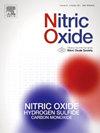Exploring the therapeutic potential of beetroot juice in patients with peripheral artery disease: A Narrative review
IF 3.2
2区 生物学
Q2 BIOCHEMISTRY & MOLECULAR BIOLOGY
引用次数: 0
Abstract
Peripheral artery disease (PAD) is a circulatory disorder caused by atherosclerosis, leading to the narrowing or blockage of peripheral arteries, often affecting the arteries in the lower limbs. This condition can result in intermittent claudication and severe limb ischemia, significantly reducing patients' quality of life. In recent years, increasing evidence suggests that dietary interventions play a crucial role in the prevention and management of PAD, offering a safe and non-invasive treatment option. Beetroot, a natural root vegetable, demonstrates significant health benefits through its various bioactive compounds. It is rich in nitrate and betaine, which are metabolized in the body via the nitrate-nitrite- nitric oxide (NO) pathway, increasing the bioavailability of NO. NO is an important vasodilator that can improve blood flow and lower blood pressure. Additionally, the active compounds in beetroot may further enhance its health effects by altering the activity of the oral microbiome. This review explores the potential therapeutic effects of beetroot juice (BRJ) in the management of PAD. The findings indicate that BRJ can improve exercise performance, lower blood pressure, improve endothelial function, enhance skeletal muscle microvascular function and central autonomic nervous system function. Based on these findings, beetroot and its rich bioactive compounds hold promise as a novel supportive therapy for improving PAD.
探讨甜菜根汁治疗外周动脉疾病的潜力:一个叙述性的回顾
外周动脉疾病(PAD)是一种由动脉粥样硬化引起的循环系统疾病,导致外周动脉变窄或阻塞,常累及下肢动脉。这种情况可导致间歇性跛行和严重肢体缺血,显著降低患者的生活质量。近年来,越来越多的证据表明,饮食干预在PAD的预防和管理中起着至关重要的作用,提供了一种安全、无创的治疗选择。甜菜根,一种天然根茎类蔬菜,通过其多种生物活性化合物显示出显著的健康益处。它富含硝酸盐和甜菜碱,通过硝酸盐-亚硝酸盐-一氧化氮(NO)途径在体内代谢,提高NO的生物利用度。一氧化氮是一种重要的血管扩张剂,可以改善血液流动和降低血压。此外,甜菜根中的活性化合物可能通过改变口腔微生物群的活性进一步增强其健康效果。本文综述了甜菜根汁(BRJ)在PAD治疗中的潜在治疗作用。研究结果表明,BRJ可以提高运动成绩,降低血压,改善内皮功能,增强骨骼肌微血管功能和中枢自主神经系统功能。基于这些发现,甜菜根及其丰富的生物活性化合物有望成为改善PAD的新型支持疗法。
本文章由计算机程序翻译,如有差异,请以英文原文为准。
求助全文
约1分钟内获得全文
求助全文
来源期刊

Nitric oxide : biology and chemistry
生物-生化与分子生物学
CiteScore
7.50
自引率
7.70%
发文量
74
审稿时长
52 days
期刊介绍:
Nitric Oxide includes original research, methodology papers and reviews relating to nitric oxide and other gasotransmitters such as hydrogen sulfide and carbon monoxide. Special emphasis is placed on the biological chemistry, physiology, pharmacology, enzymology and pathological significance of these molecules in human health and disease. The journal also accepts manuscripts relating to plant and microbial studies involving these molecules.
 求助内容:
求助内容: 应助结果提醒方式:
应助结果提醒方式:


